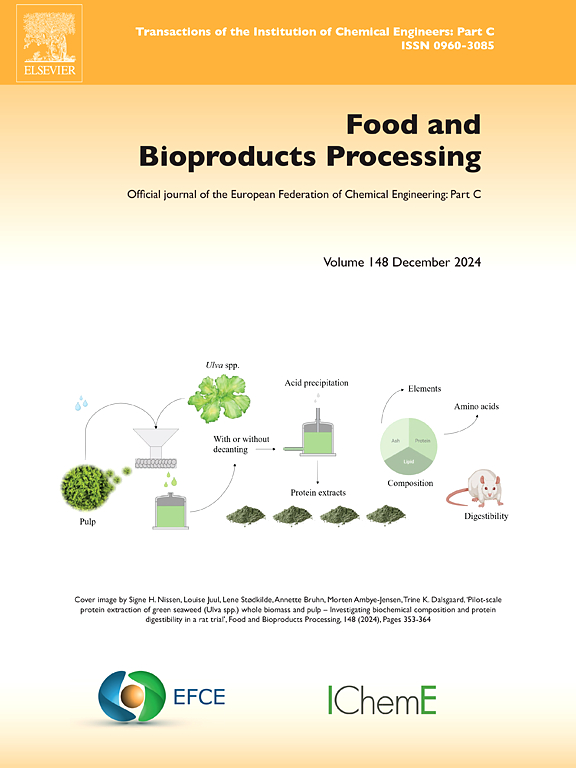无花果叶中酚类物质的提取优化
IF 3.4
2区 农林科学
Q2 BIOTECHNOLOGY & APPLIED MICROBIOLOGY
引用次数: 0
摘要
本研究探讨了从无花果叶中提取生物活性化合物的绿色溶剂的潜力,重点是效率、可持续性和抗氧化能力。使用丙酮、甲醇和水进行了比较评估,后者因其环境效益和高提取率而被认为是最有效的溶剂。考察了pH、温度和时间对提取的影响。结果表明,微酸性、适宜的温度和较短的提取时间有利于芦丁、绿原酸和槲皮素等酚类化合物的提取。优化后的条件,较低的温度(37.5°C),较短的提取时间(1-5 min),以及中性至微酸性的pH值(pH 5-7),在工业上是可行的,因为它们有助于最大限度地减少能耗和处理时间。水提取的无花果叶多酚显示出显著的抗氧化活性,使其成为有前途的食品强化天然添加剂。这些发现突出了农业副产品的经济和生态优势,有助于循环经济实践。需要进一步的研究来验证可扩展性和探索工业应用。潜在的用途包括延长食品的保质期和功能特性。这项工作强调了向更环保的提取方法过渡的重要性,这种方法可以扩展到其他叶子材料,同时解决环境问题并释放具有商业价值的传统被忽视的资源。本文章由计算机程序翻译,如有差异,请以英文原文为准。
Phenolic extraction optimisation from fig leaf waste
This study explores the potential of green solvents for extracting bioactive compounds from fig leaves, focusing on efficiency, sustainability, and antioxidant capacity. Comparative evaluations were performed using acetone, methanol, and water, with the latter identified as the most effective solvent due to its environmental benefits and robust extraction yields. The influence of pH, temperature, and time on extraction was also assessed. Results revealed that a slightly acidic pH, moderate temperatures, and short extraction times optimised the recovery of phenolic compounds, including rutin, chlorogenic acid, and quercetin. The optimised conditions, lower temperatures (37.5°C), short extraction times (1–5 min), and a neutral to slightly acidic pH (pH 5–7), are industrially viable, as they help minimise energy consumption and processing duration. Water-extracted fig leaf polyphenols demonstrated significant antioxidant activity, positioning them as promising natural additives for food fortification. These findings highlight the economic and ecological advantages of agricultural by-products, contributing to circular economy practices. Further research is needed to validate scalability and explore industrial applications. Potential uses include enhancing the shelf life and functional properties of food products. This work underscores the importance of transitioning toward greener extraction methodologies that could extend to other leaf materials while addressing environmental concerns and unlocking traditional overlooked resources with commercial value.
求助全文
通过发布文献求助,成功后即可免费获取论文全文。
去求助
来源期刊

Food and Bioproducts Processing
工程技术-工程:化工
CiteScore
9.70
自引率
4.30%
发文量
115
审稿时长
24 days
期刊介绍:
Official Journal of the European Federation of Chemical Engineering:
Part C
FBP aims to be the principal international journal for publication of high quality, original papers in the branches of engineering and science dedicated to the safe processing of biological products. It is the only journal to exploit the synergy between biotechnology, bioprocessing and food engineering.
Papers showing how research results can be used in engineering design, and accounts of experimental or theoretical research work bringing new perspectives to established principles, highlighting unsolved problems or indicating directions for future research, are particularly welcome. Contributions that deal with new developments in equipment or processes and that can be given quantitative expression are encouraged. The journal is especially interested in papers that extend the boundaries of food and bioproducts processing.
The journal has a strong emphasis on the interface between engineering and food or bioproducts. Papers that are not likely to be published are those:
• Primarily concerned with food formulation
• That use experimental design techniques to obtain response surfaces but gain little insight from them
• That are empirical and ignore established mechanistic models, e.g., empirical drying curves
• That are primarily concerned about sensory evaluation and colour
• Concern the extraction, encapsulation and/or antioxidant activity of a specific biological material without providing insight that could be applied to a similar but different material,
• Containing only chemical analyses of biological materials.
 求助内容:
求助内容: 应助结果提醒方式:
应助结果提醒方式:


